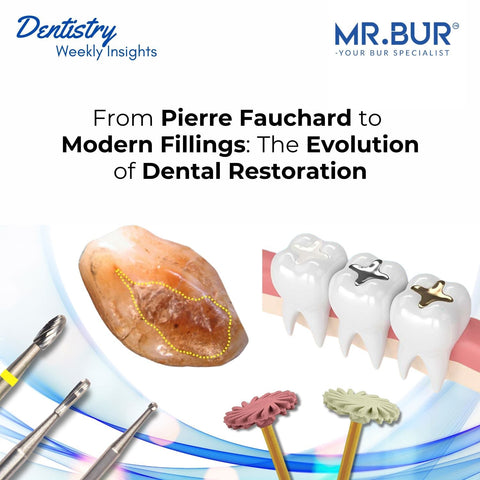The field of dentistry has undergone significant transformations over the centuries, but few innovations have had as profound an impact as the invention of the Airotor high-speed handpiece by Dr. John V. Borden in 1957. Before this breakthrough, caries removal was an arduous and uncomfortable process for both patients and dentists. Borden’s invention not only sped up cavity preparation but also enhanced precision and patient comfort, shaping the modern practice of restorative dentistry. This article explores the evolution of cavity preparation, the invention of the Airotor, and how it revolutionized dental bur functionality in the caries removal process.
The Evolution of Cavity Preparation: From Manual Methods to Mechanized Drilling
Before the introduction of mechanized dental handpieces, early dentistry relied on rudimentary tools and manual techniques for cavity preparation:
-
Pre-19th Century: Dentists used long, slender burs, manually twirled between the fingers or spun with a small bow in a sawing motion to remove decayed tooth material. Due to the slow and tedious process, many cavities were simply plugged with lead or gutta-percha without proper excavation.
-
Mid-19th Century: The need for speed led to the invention of the foot-treadle-powered dental engine by James Morrison in 1872. This innovation increased drill speeds, improving efficiency but still producing significant discomfort for patients due to heat and vibration.

-
Early 20th Century: The introduction of belt-driven handpieces further mechanized the process, but speeds remained limited to around 2,000 RPM, making cavity preparation slow and often painful.
-
Post-World War II Advancements: The introduction of tungsten carbide and diamond burs allowed for more effective cutting, but their full potential was restricted by the slow speed of existing drills (6,500 RPM by 1950).
The Birth of High-Speed Dental Handpieces: Dr. Borden’s Innovation
As dentistry progressed, the demand for a faster and more efficient cavity preparation tool grew. Inspired by the principles of jet turbine technology, Dr. John V. Borden filed a patent for the Airotor in 1957. This revolutionary handpiece operated at speeds of 250,000+ RPM, a monumental leap from previous handpieces.
Key Innovations of the Airotor:
-
Air-Turbine Mechanism: Unlike traditional belt-driven models, Borden’s Airotor used compressed air to spin the bur at incredibly high speeds, allowing for faster and smoother cutting.
-
Reduced Heat and Friction: The high-speed rotation minimized vibration and heat production, improving patient comfort and reducing post-procedure sensitivity.
-
Greater Precision: Faster bur rotation meant cleaner cavity preparations with minimal removal of healthy tooth structure, leading to better-fitting restorations.
-
Shorter Chair Time: Procedures that previously took longer due to slow caries removal could now be completed in a fraction of the time.
Enhancing Dental Bur Functionality in Cavity Preparation
The Airotor didn’t just make dentistry faster—it also unlocked the full potential of dental burs. Before high-speed handpieces, burs were limited by low RPM drills, making them inefficient at cutting enamel and dentin. With the introduction of the Airotor:
-
Tungsten carbide and diamond burs could be used more effectively, increasing cutting efficiency and reducing force needed for cavity excavation.
-
The precise control of bur movement enabled minimally invasive dentistry, preserving more natural tooth structure while ensuring thorough decay removal.
-
New bur designs optimized for high-speed cutting emerged, leading to advancements in cavity preparation techniques, crown preparation, and even surgical procedures.
The Lasting Impact on Modern Dentistry
Dr. Borden’s Airotor handpiece forever changed the landscape of dental procedures. Today, nearly all modern dental practices utilize air-driven or electric high-speed handpieces based on Borden’s design. The improvements in:
-
Efficiency: Dentists can perform more treatments in a shorter time.
-
Patient Comfort: Less heat, vibration, and shorter treatment durations.
-
Precision: High-speed burs allow for more conservative and accurate restorations.
Even after decades, Dr. Borden’s contribution remains at the core of every dental practice, making cavity preparation quicker, more precise, and less painful for patients worldwide.
Final Insight
Dr. John V. Borden’s invention of the Airotor in 1957 marked a turning point in the history of dentistry. His application of air-turbine technology not only transformed cavity preparation but also enhanced the functionality of dental burs, making procedures faster, more precise, and significantly more comfortable for patients. Today, his legacy lives on in every high-speed dental handpiece, proving that innovation can reshape an entire profession.
Diamond Burs, Carbide Burs, Surgical & Lab Use Burs, Endodontic burs, IPR Kit, Crown Cutting Kit, Gingivectomy Kit, Root Planning Kit, Orthodontic Kit, Composite Polishers, High Speed Burs, Low Speed Burs




